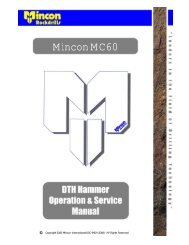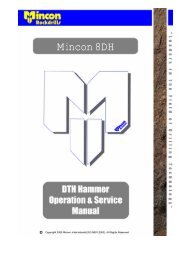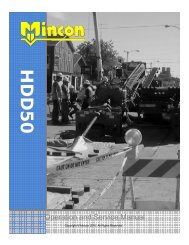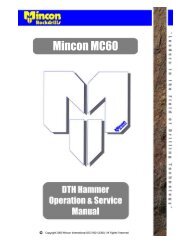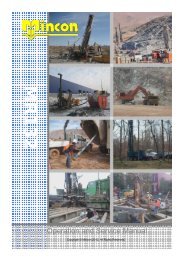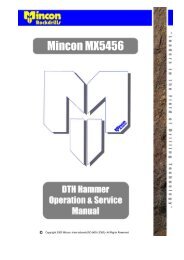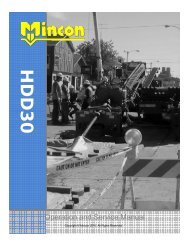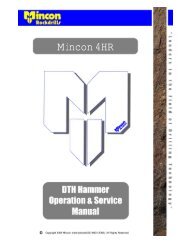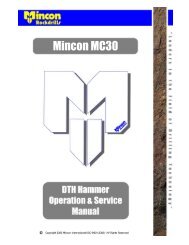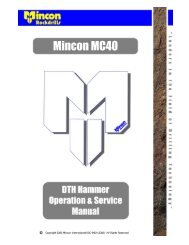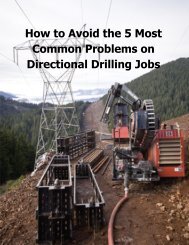Mincon MP55
Mincon MP55 - Manufacturer of Top Quality Rockdrills including bits ...
Mincon MP55 - Manufacturer of Top Quality Rockdrills including bits ...
You also want an ePaper? Increase the reach of your titles
YUMPU automatically turns print PDFs into web optimized ePapers that Google loves.
2.3.2 Opening Chuck and BackheadThe threads used in <strong>Mincon</strong> Hammers are right hand threads. Proper tools and break-out systems should be used at all times todismantle DTH hammers, otherwise damage may be caused to the components which could result in eventual failure or affect theperformance of the Hammer. When using Petol wrenches or similar systems, ensure that the wrench is not placed on the threadedsection of the wear sleeve. Petol wrench jaws should be carbide, and in good condition. It is good practice to keep a spare set ofjaws with the rig. Do not strike or hit the outer components as this could weaken the heat treated steels. Hitting the hammer mayalso cause hard metal fragments to be chipped off which may be projected and cause personal injury or eyesight loss.Do not apply heat to the hammer, as this can alter the metallurgical composition and result in premature failure. Additionally,applying heat can also cause distortion to the wear sleeve, which in turn would lead to failure. Do not trap the hammer under drillrig tracks or vehicle wheels which could cause bending and distortion of the hammer body. Failures caused by these actionscannot be supported by warranty.Take care when dismantling the hammer to make sure that parts and drill bits do not become detached and cause damage orpersonal injury.2.3.3 Dismantling Hammer to Change Drill BitWhen possible, dismantling the Hammer to change the drill bit is preferably best done in a workshop environment to avoid the riskof injury and for cleanliness. Be careful to ensure that the drill bit and chuck are fully supported together so that there is no risk ofthem becoming detached and causing injury. This can occur if the O Ring on the bit retaining rings is missing or damaged. Beforefitting a new drill bit visually inspect the splines of the chuck and the piston striking face to ensure that both are not damaged in anyway.Place chuck onto the bit, and secure with the bit retaining rings above the chuck. The <strong>MP55</strong> bit retaining rings are reversible.Liberally grease the threads on the chuck. Screw chuck into wear sleeve by hand, alternatively, if using the rig to screw chuck on,ensure that no cross threading occurs. Prior to use, place bit in a bit basket and torque up chuck. This is essential, as the chuckcan loosen if not properly torqued, and premature chuck failure can occur.2.3.4 Disassembly for Full Servicing of HammerBreakout the Chuck and Backhead as described previously. Unscrew chuck and remove bit and bit retaining rings. Unscrew thebackhead and check to see if the check valve and spring are operating correctly, and then remove them. Mark one end to identifyeither the chuck or backhead end for reassembly latter.Stand hammer up with the chuck end uppermost. Using a mild steel bar, tap the strike face of the piston to remove the airdistributor and inner cylinder. The steel make-up ring and lock ring should fall out during this process, if so remove them andcontinue until the top of the air distributor is at the top of the wear sleeve. The hammer can now be placed flat on the ground or putup onto a suitable vice, and using the mild steel bar, hit the piston strike face from the chuck end, to completely remove the airdistributor, inner cylinder and piston.Stand the wear sleeve up with the chuck end on the ground. Invert the piston and drop into the wear sleeve so that it is upsidedown. Take care to ensure that fingers do not get caught between the piston and wear sleeve. Again stand the hammer up withthe backhead end uppermost, and tap the piston strike face with the mild steel bar to remove the aligner. A number of blows maybe necessary as the aligner and wear sleeve are an interference fit. The piston retaining ring will come out with the aligner.2.3.5 InspectionPrior to inspection, thoroughly clean all parts using a suitable cleaning agent. Diesel is not recommended for cleaning as it cancause erosion to components, and damage to health.All parts should be visually inspected for any signs of damage, wear or cracking. The inner cylinder, wear sleeve and lock rings canbe checked for unseen cracking by suspending them and lightly tapping with a screw driver. If they emit a ringing tone then theyshould be sound. However, a dull flat tone if emitted may indicate cracking, and the part should be replaced.Take particular care to check the internal bore of the wearsleeve for pick-up marks and galling. If these are present, the barrel ofthe wear sleeve should be honed out, using a hand hone to remove them.Inspect surface of the piston for pick-up marks and galling (usually caused through poor lubrication or the presence ofcontaminants) and smooth out with emery paper or a hand held grit stone. Where galling of the piston has occurred, substantialheat has been generated and quite often, micro cracking has occurred on the piston. In these cases, the piston should be replacedif there is evidence of such cracking. Check the strike face of the piston for cracking or damage.2.3.6 Checking Wear LimitsThe performance of the hammer is dependent on the amount of wear the critical components have. These should be measuredand recorded in the Service log in the appendix. The service log gives the location of where measurements should be made.Depending on how many parts need to be replaced, it may be economical to replace the hammer all together.<strong>Mincon</strong> Rockdrills – “The Driller’s Choice” Page 5



